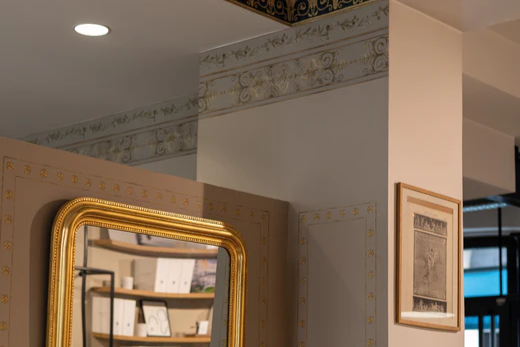The store gets a makeover.
Come and discover our new showroom inspired by the Directoire decor of the Hôtel de Bourrienne. The midnight-blue and gold friezes of Fortunée Hamelin's bathroom now adorn the walls of our fitting rooms, creating a cocoon where we can advise you on your choice of Bourrienne shirts.
A huge thank you to Mélissa at Mues Design for creating these decors.
Let's take a moment to relive the history of this unique Parisian landmark
Located in the Faubourg Poissonnière, this delightful mansion was built from 1787 onwards by architect Célestin-Joseph Happe. In 1792, the house was sold to Jérome Lormier-Lagrave, a wealthy sugarcane planter in Saint-Domingue. That same year, his only daughter Fortunée (1776-1851) married Romain Hamelin, the son of a wealthy farmer-general.
Madame Hamelin, France's biggest rascal
In 1795, Fortunée Hamelin in herited the hotel. Intelligent and impertinent, she turned her home into one of the most sought-after salons of her era. In June 1797, Madame Hamelin caused a sensation when she strolled down the Champs-Elysées in a skimpy dress slit to the hips, concealing nothing of her bosom.
Endowed with an uncommon, intrepid spirit, Madame Hamelin was a trendsetter, embodying the ideal of "la merveilleuse". Full of mischief, very enterprising with men, she was nicknamed "France's greatest rascal".
Her intelligence seduced the most important figures of her time: Talleyrand, Bonaparte, Chateaubriand, Victor Hugo.
A loyal friend of General Bonaparte
In 1801, the hotel was bought by Louis-Antoine Fauvelet de Bourrienne
(1769-1834). At the time, he was private secretary and Conseiller d'Etat to General Bonaparte, 1st Consul of the Republic.
In 1805, Bourrienne was appointed minister in Hamburg. He remained loyal to the Emperor until his fall in 1814.
Unique Directoire decor in Paris
The hotel has preserved some very rare antique decorations from this period, which are virtually unique in Paris, and are a magnificent illustration of the Directoire and Consulat styles.
The murals are inspired by Pompei and Herculaneum, rediscovered in the mid-18th century. Elements of the Neoclassical repertoire are evident in the decor: figures draped in antique style, candelabras, vases and palmettes.The most singular room is the bathroom, with its Etruscan decor, heralding the concern for comfort that was to characterize the 19th century.





